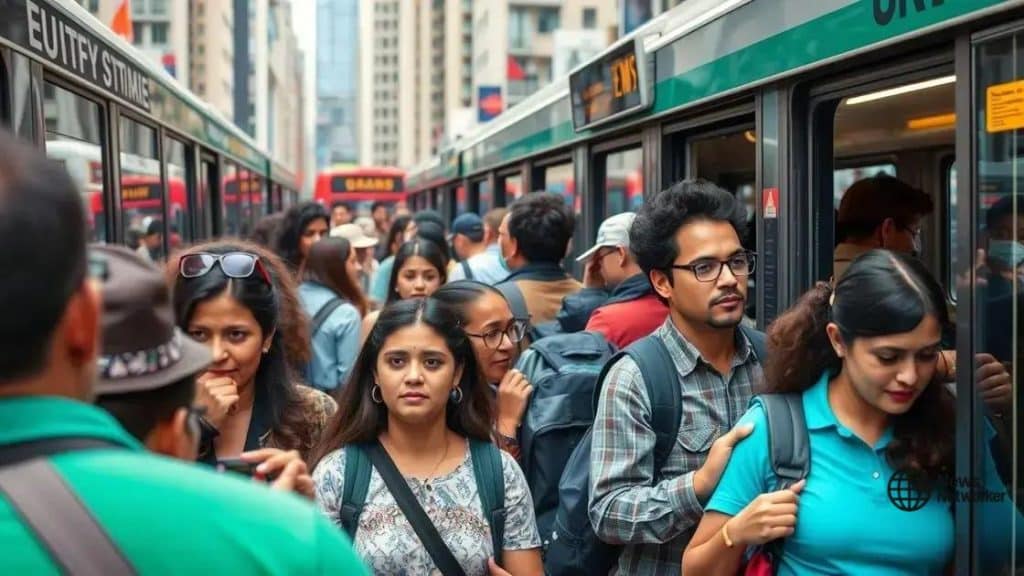Transportation subsidies: enhancing mobility for low-income workers

Transportation subsidies enhance mobility for low-income workers by reducing commuting costs, improving access to jobs and essential services, and promoting overall economic stability within communities.
Transportation subsidies play a crucial role in improving access for low-income workers. Ever thought about how a bus pass can change someone’s life? Let’s dive into their importance and effects.
understanding transportation subsidies
Understanding transportation subsidies is essential to appreciate how they can improve access and mobility for low-income individuals. These subsidies aim to reduce transportation costs, making it easier for workers to reach jobs, education, and essential services.
What Are Transportation Subsidies?
Transportation subsidies are financial assistance programs provided by governments or organizations to lower the cost of public transport for specific groups. They can come in various forms, such as discounts on fares, free passes, or vouchers. The goal is to make travel more affordable, particularly for those in need.
Types of Transportation Subsidies
- Direct fare discounts: Reduced prices for public transport users.
- Subsidized travel vouchers: Coupons that help cover transport costs.
- Free shuttle services: Transportation provided from certain locations, such as low-income housing.
- Employer-sponsored programs: Employers offering transport benefits to their staff.
These programs are vital in urban areas where public transport is the main option for commuting. Lowering the cost of travel is especially important for low-income communities, where every dollar counts. For instance, a worker who spends less on transit can allocate those savings to other essential needs, such as food and healthcare.
The Importance of Understanding Transportation Subsidies
Recognizing how these subsidies work can empower individuals and communities. Many do not know they qualify for such programs, leading to missed opportunities. Local government websites often provide information regarding available subsidies, eligibility criteria, and application processes.
By informing low-income workers about transportation subsidies, we help break the barriers that limit their mobility. When people can travel more freely, they can access employment opportunities, engage in education, and participate more fully in their communities. Improving access through these programs not only benefits individuals but also strengthens the economy by ensuring that a greater workforce can engage in productive activities.
the impact on mobility for low-income workers
The impact of transportation subsidies on mobility for low-income workers is profound and multi-faceted. By making public transit more affordable, these subsidies open up opportunities that may have been previously out of reach.
Enhancing Access to Employment
For low-income workers, transportation subsidies can be a game-changer. Many jobs are located far from residential areas, making the commute a significant hurdle. With subsidies, workers can access these jobs more easily. Not only does this increase their chances of securing employment, but it also enables them to work more hours, leading to greater financial stability.
Connecting to Essential Services
Mobility is also crucial for accessing essential services such as healthcare, education, and childcare. When low-income individuals can afford to travel, they are more likely to attend medical appointments, enroll in educational programs, and find reliable childcare. This connectivity can lead to a healthier and more educated workforce.
- Healthcare: Timely access to medical care improves overall health outcomes.
- Education: Increased attendance at training programs boosts job skills.
- Childcare: Reliable transportation helps parents find and maintain safe childcare options.
Furthermore, the ripple effect of enhanced mobility creates stronger communities. When low-income workers can commute effectively, their involvement in local events and services increases. They become active participants in their neighborhoods, leading to vibrant community interactions.
Reducing Transportation Costs
Transportation subsidies directly decrease the cost burden on low-income households. Without these subsidies, many workers must allocate a large part of their income to commuting, leaving less for other essential expenses. With available financial assistance, these households can thrive without the constant stress of transportation costs.
Overall, the impact of subsidies on mobility for low-income workers extends beyond mere transportation. It encompasses economic stability, access to critical services, and community engagement. When individuals can travel freely and affordably, it fosters growth and transformation for both them and their communities.
case studies of successful subsidy programs

Examining case studies of successful subsidy programs provides valuable insights into how these initiatives can effectively support low-income workers. Success stories from various regions show the positive impact of transportation subsidies on communities.
Case Study: New York City
In New York City, the MTA introduced a discounted MetroCard program for low-income commuters. This initiative significantly reduced travel costs for many workers, allowing them to access jobs across the five boroughs. The program helped connect individuals to employment opportunities and essential services, resulting in increased economic activity in several neighborhoods.
Case Study: San Francisco
San Francisco’s Clipper Card program offers discounts to eligible low-income residents. This program provides seamless access to multiple transit options, including buses, trains, and ferries. The integration encourages more people to use public transport, thereby reducing traffic congestion and pollution. Many users report that the subsidies allow them to save on commuting costs, improving their overall quality of life.
- Enhanced Accessibility: Workers can travel more freely and easily.
- Increased Job Retention: Lower costs help workers maintain employment.
- Improved Community Engagement: More accessible transport fosters participation in local events.
These case studies illustrate that well-implemented transportation subsidy programs can create a significant ripple effect. When low-income individuals can afford to commute, they contribute to their local economies, creating a more vibrant and interconnected community. By learning from these examples, other cities can develop similar programs tailored to their unique needs.
Case Study: Chicago
In Chicago, the Transit Benefit Program offers subsidies through employers. Employees can choose to allocate pre-tax dollars toward their commuting expenses. This program has successfully incentivized companies to support their workforce’s transportation needs. It not only helps employees save money but also promotes the use of public transit, which benefits the environment.
These successful case studies highlight the importance of understanding and promoting transportation subsidy programs. They demonstrate how effective policies can lead to positive outcomes for both individuals and communities, ultimately transforming lives for the better.
challenges in implementing transportation subsidies
Implementing transportation subsidies comes with various challenges that can hinder their success. Understanding these barriers is crucial for creating effective programs that truly benefit low-income workers.
Funding and Budget Constraints
One of the significant challenges is securing adequate funding. Many municipalities face budget limitations that restrict the ability to offer comprehensive subsidies. Without proper financial backing, subsidies may be too minimal to make a meaningful impact on the users.
Administrative Complexities
Another issue is the complexity of administering these programs. Establishing eligibility criteria and efficiently processing applications can be labor-intensive and time-consuming. Each step requires transparency and efficiency to avoid delays that may discourage potential recipients from applying.
- Eligibility determination: Ensuring that only qualified individuals receive funds can be complicated.
- Streamlined processes: Programs require efficient systems to manage applications and disburse funds.
- Communication: Providing clarity about available subsidies is necessary to ensure low-income workers know their options.
Moreover, there’s also the challenge of public awareness. Many low-income individuals may not know about their eligibility for subsidies. Effective outreach strategies are essential to inform communities about these programs, allowing them to benefit fully.
Equity and Accessibility Issues
The implementation of transportation subsidies must also consider equity. Ensuring that subsidies reach the most disadvantaged groups is critical. For instance, rural communities might struggle more with transportation issues compared to urban areas, yet they often receive less attention in subsidy programs.
Equally important is ensuring that the public transit systems receiving subsidies are accessible to everyone, including those with disabilities. A subsidy program is only effective if it addresses the transportation needs of all eligible individuals.
Addressing these challenges requires collaboration between policymakers, community organizations, and the public. When stakeholders come together, they can create more effective and responsive transportation subsidy programs that truly enhance mobility for low-income workers.
future of transportation subsidies in policy
The future of transportation subsidies in policy holds great potential for enhancing mobility and accessibility for low-income workers. As cities continue to grow and evolve, policymakers face the challenge of adapting transport systems to meet the diverse needs of their residents.
Innovative Funding Solutions
One trend is the exploration of innovative funding mechanisms. Public-private partnerships are becoming more popular, allowing private companies to invest in public transit systems. This collaboration can lead to more sustainable funding for transportation subsidies, ensuring that low-income individuals have continued access to affordable transportation.
Incorporating Technology
Another important aspect is the integration of technology in transportation subsidies. Advancements in mobile apps and digital platforms can streamline the application process, making it easier for individuals to access subsidy information and services. Moreover, technology can help track usage patterns, allowing policymakers to tailor programs to meet the specific needs of the community.
- Data analysis: Using data to improve subsidy allocation and effectiveness.
- Mobile access: Apps making it easier for users to apply for and manage subsidies.
- Real-time updates: Providing users with current information about transportation options and subsidies.
Additionally, advocating for comprehensive policies that address systemic barriers faced by low-income individuals will be key. This includes ensuring that public transit systems are not only affordable but also reliable and efficient. Improved transit options will help lift families out of poverty by ensuring they can access jobs and services.
Focus on Environmental Sustainability
As cities become more focused on sustainability, the future of transportation subsidies may also lean towards promoting green transport options. This might include increased support for electric buses and bike-sharing programs. By prioritizing environmentally friendly transport solutions, policymakers can work towards a cleaner and more equitable mobility framework.
The future landscape of transportation subsidies will likely involve greater collaboration, technological integration, and a focus on sustainability. By addressing current challenges and anticipating future needs, policymakers can create programs that effectively support low-income workers now and in the years to come.
FAQ – Frequently Asked Questions about Transportation Subsidies
What are transportation subsidies?
Transportation subsidies are financial assistance programs designed to help low-income individuals afford public transit, making it easier for them to access jobs and essential services.
How do transportation subsidies benefit low-income workers?
They reduce commuting costs, improve access to employment and healthcare, and enhance overall mobility for low-income individuals.
What challenges do policymakers face in implementing transportation subsidies?
Challenges include securing adequate funding, managing administrative processes, raising public awareness, and ensuring equity and accessibility for all individuals.
What is the future of transportation subsidies in policy?
The future may involve innovative funding solutions, technological integration, a focus on sustainability, and comprehensive policies that adapt to the needs of diverse communities.





